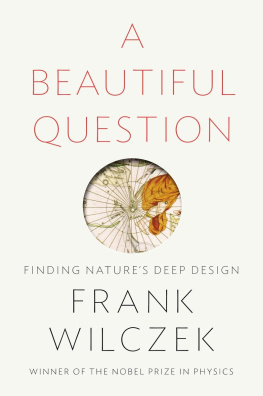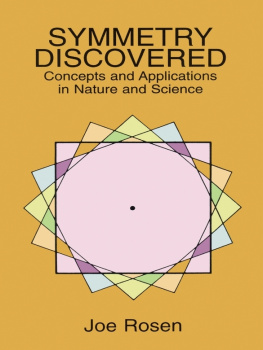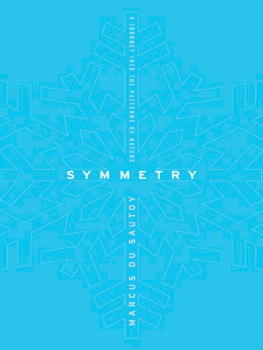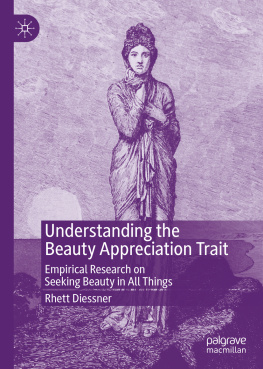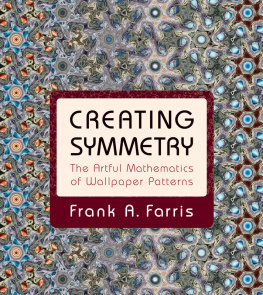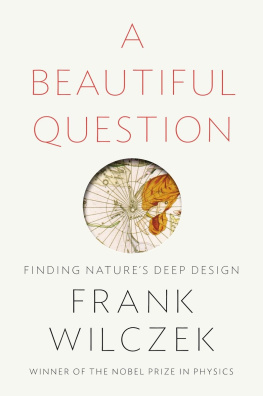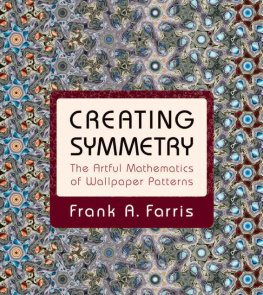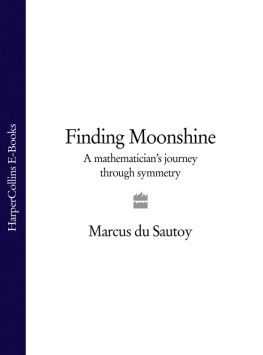ADVANCE PRAISE FOR
A Beautiful Question
A beautiful treatise on a beautiful universe, this delightful series of meditations on the nature of beauty and the physical universe roams from music to color vision to fundamental ideas at the very forefront of physics today. In lesser hands such a romp could easily degenerate into a kind of new-age mystical mumbo jumbo. However, Frank Wilczek is one of the deepest, most creative, and most knowledgeable theoretical physicists alive today. Read him or listen to him and you will never think about the universe the same way again. And if your experience is like mine over the years, you will definitely be the better for it.
L AWRENCE K RAUSS , author of A Universe from Nothing and The Physics of Star Trek
A truly beautiful book, in design, in content, in the insights that Frank Wilczek shares. This book helps me see how one of the worlds leading thinkers thinks, using beauty as a tool, as a guide in finding not only the right problems but the right solutions. In Wilczeks mind, there is no clear separation among physics, art, poetry, and music. Why do physicists call their theories beautiful? Immerse yourself in this book, wallow in it, sit back and relax as you wander through it, and youll soon understand.
R ICHARD M ULLER , author of Physics for Future Presidents
If youve ever wondered what physicists mean when they describe a theory as beautiful, A Beautiful Question is the ideal place to find out. Wilczek is both one of the greats of the subject and not afraid to engage nontechnically with the wonderful complexities and intangibilities of the mysterious beauty that lies at the core of our understanding of the physical world.
P ETER W OIT , author of Not Even Wrong
Frank Wilczek starts this fascinating book with the intriguing question Does the world embody beautiful ideas? What follows is a masterful intellectual journey, surveying a breathtaking tapestry of physics, art, and philosophy. One could ask Wilczeks question differently: Does this book embody beautiful ideas? The answer would be a resounding Yes!
M ARIO L IVIO , astrophysicist; author of Brilliant Blunders
Having made fundamental contributions to our understanding of quantum field theory, Frank Wilczek now defines new frontiers with his creations in explanation: Maxwellian spider physics, the projective geometry of Renaissance art as a model of symmetry and invariance, links between anamorphic art and local symmetry, and more. Wilczeks latest is a book with some beautiful answers.
F RANK C LOSE , author of The Infinity Puzzle and Half-Life
In contemporary art, beauty has faded and become a prosaic artifice, a distraction from deeper raw truths, maybe even ugly truths. To the exceptional physicist Frank Wilczek, beauty has proved a luminous ally, a faithful adviser in his discoveries of remarkable truths about the world. Ever in pursuit of truth, Wilczek guides us in a calm and winsome meditation on this subtle question: Is the world beautiful?
J ANNA L EVIN , author of How the Universe Got Its Spots
Anyone who has studied physics knows the startling beauty of those rare times when the clouds part and you see that math and reality are the same thing. With Wilczeks new book, readers can catch a glimpse of that beauty without having to know the math.
N OAH S MITH , Stony Brook University; author of the blog Noahpinion
A LSO BY F RANK W ILCZEK
The Lightness of Being
Fantastic Realities
Longing for the Harmonies
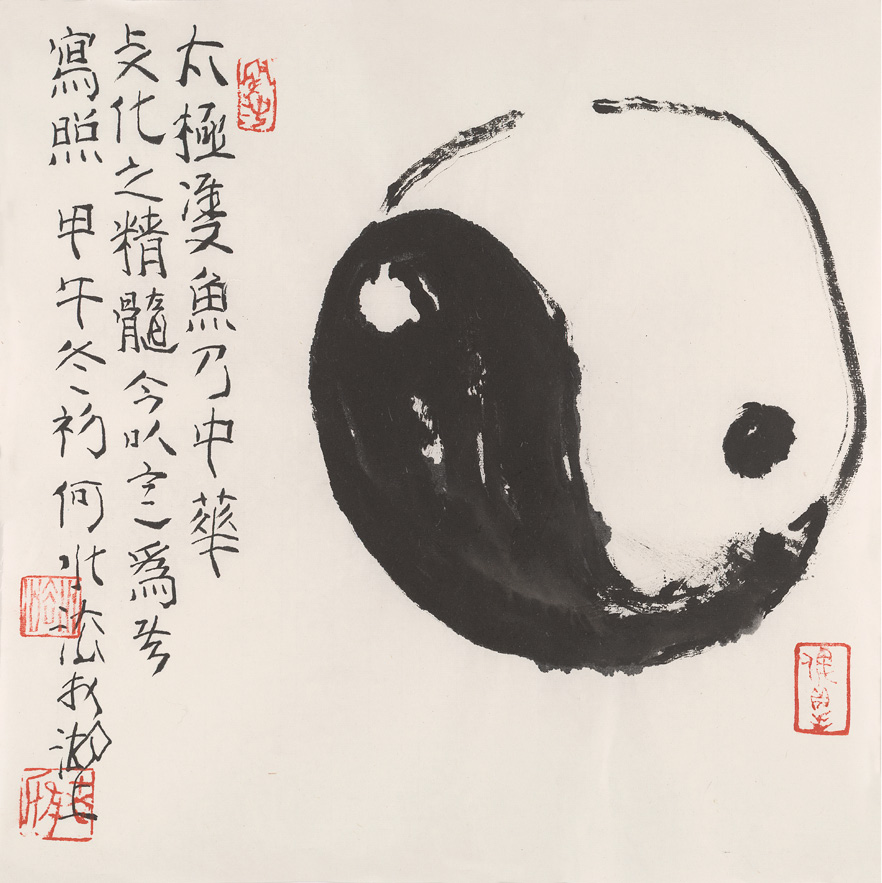
This work was prepared especially for A Beautiful Question by He Shuifa,a modern master of traditional Chinese art and calligraphy. He is renownedfor the vigor and subtlety of his brushwork and for the spiritual depth of hisdepictions of flowers, birds, and nature. A simple translation of the inscriptionis this: Taiji double fish is the essence of Chinese culture. This imagewas painted by He Shuifa on a lake in early winter. The playful doublefish aspect of Taiji comes to life in He Shuifas image. The yin and yangresemble two carp playing together, and there are hints of their eyes and fins.In Henan, on the Yellow River, there is a waterfall called Dragons Gate.Yulong carp attempt to jump the cataract, although it is very difficult forthem. Those that succeed transform into lucky dragons. With a sense ofhumor, we may associate this event with the transformation of virtual intoreal particles, an essential quantum process that is now thought to underliethe origin of structure in the Universe (see ). Alternativelywe may identify ourselves with the carp, and their strivings with ourquest for understanding.

PENGUIN PRESS
An imprint of Penguin Random House LLC
375 Hudson Street
New York, New York 10014
penguin.com
Copyright 2015 by Frank Wilczek
Penguin supports copyright. Copyright fuels creativity, encourages diverse voices, promotes free speech, and creates a vibrant culture. Thank you for buying an authorized edition of this book and for complying with copyright laws by not reproducing, scanning, or distributing any part of it in any form without permission. You are supporting writers and allowing Penguin to continue to publish books for every reader.
ISBN 978-0-698-19562-2
Version_1
TO MY FAMILY AND FRIENDS: BEAUTIFUL ANSWERS OF THE SECOND KIND
USERS MANUAL
- The Timelines are mainly focused on events mentioned or alluded to in the book. They do what timelines do. They are not intended to be complete histories of anything, and they arent.
- The Terms of Art section contains explanatory definitions and discussions of key terms and concepts that occur in the main text. As you can infer from its length, it is rather more than a standard glossary. It contains alternative perspectives on many ideas in the text, and develops a few in new directions.
- The Notes section contains material that might, in an academic setting, have gone into footnotes. It both qualifies the text and provides some more technical references on particular points. Youll also find a pair of poems in there.
- The brief Recommended Reading section is not a routine list of popularizations, nor of textbooks, but a carefully considered set of recommendations for further exploration in the spirit of the text, emphasizing primary sources.
I hope youve already enjoyed the cover art and the frontispiece, which set the tone for our meditation beautifully.
Theres also a Users Manualbut you knew that.
THE QUESTION
T his book is a long meditation on a single question:
Does the world embody beautiful ideas?
Our Question may seem like a strange thing to ask. Ideas are one thing, physical bodies are quite another. What does it mean to embody an idea?
Embodying ideas is what artists do. Starting from visionary conceptions, artists produce physical objects (or quasi-physical products, like musical scores that unfold into sound). Our Beautiful Question, then, is close to this one:
Is the world a work of art?
Posed this way, our Question leads us to others. If it makes sense to consider the world as a work of art, is it a successful work of art? Is the physical world, considered as a work of art, beautiful? For knowledge of the physical world we call on the work of scientists, but to do justice to our questions we must also bring in the insights and contributions of sympathetic artists.

